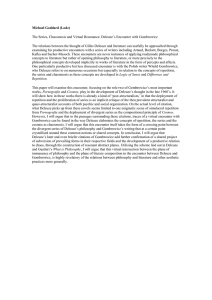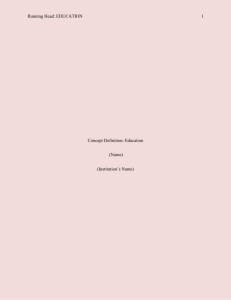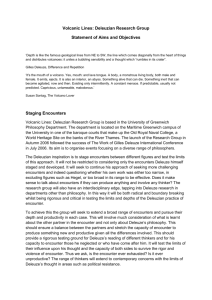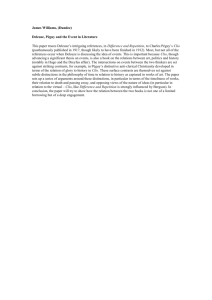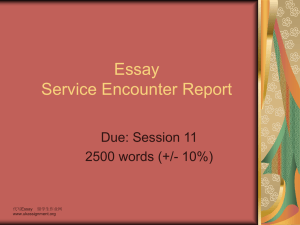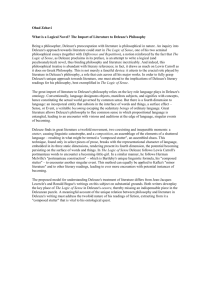Education as an Encounter: A Philosophy of Teaching
advertisement
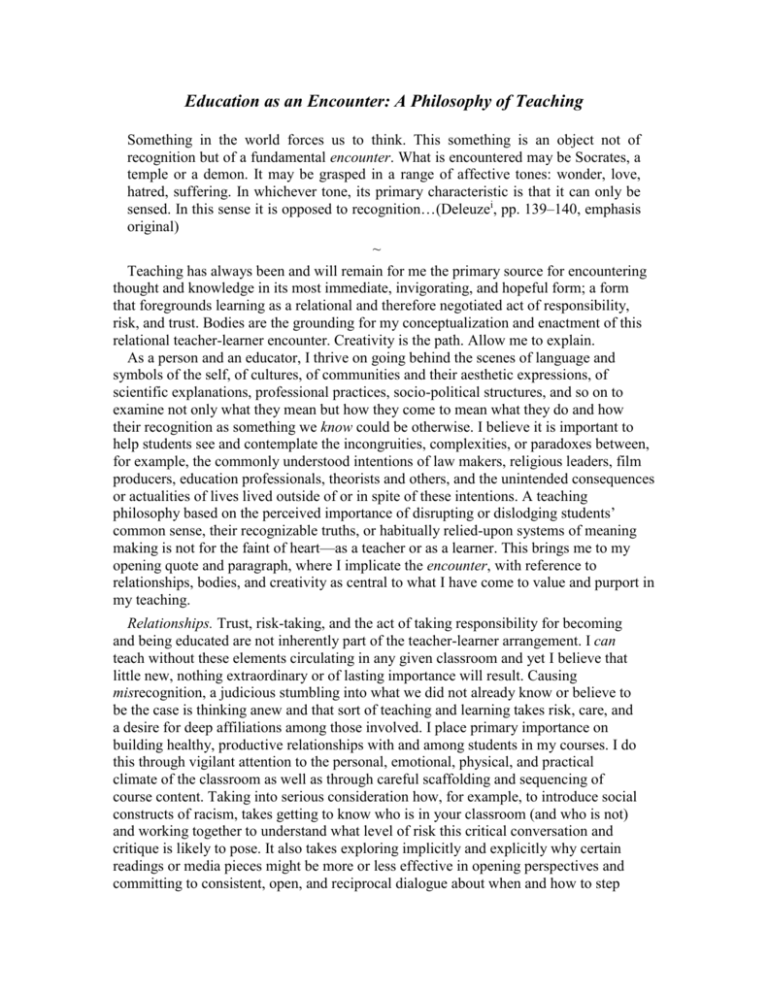
Education as an Encounter: A Philosophy of Teaching Something in the world forces us to think. This something is an object not of recognition but of a fundamental encounter. What is encountered may be Socrates, a temple or a demon. It may be grasped in a range of affective tones: wonder, love, hatred, suffering. In whichever tone, its primary characteristic is that it can only be sensed. In this sense it is opposed to recognition…(Deleuzei, pp. 139–140, emphasis original) ~ Teaching has always been and will remain for me the primary source for encountering thought and knowledge in its most immediate, invigorating, and hopeful form; a form that foregrounds learning as a relational and therefore negotiated act of responsibility, risk, and trust. Bodies are the grounding for my conceptualization and enactment of this relational teacher-learner encounter. Creativity is the path. Allow me to explain. As a person and an educator, I thrive on going behind the scenes of language and symbols of the self, of cultures, of communities and their aesthetic expressions, of scientific explanations, professional practices, socio-political structures, and so on to examine not only what they mean but how they come to mean what they do and how their recognition as something we know could be otherwise. I believe it is important to help students see and contemplate the incongruities, complexities, or paradoxes between, for example, the commonly understood intentions of law makers, religious leaders, film producers, education professionals, theorists and others, and the unintended consequences or actualities of lives lived outside of or in spite of these intentions. A teaching philosophy based on the perceived importance of disrupting or dislodging students’ common sense, their recognizable truths, or habitually relied-upon systems of meaning making is not for the faint of heart—as a teacher or as a learner. This brings me to my opening quote and paragraph, where I implicate the encounter, with reference to relationships, bodies, and creativity as central to what I have come to value and purport in my teaching. Relationships. Trust, risk-taking, and the act of taking responsibility for becoming and being educated are not inherently part of the teacher-learner arrangement. I can teach without these elements circulating in any given classroom and yet I believe that little new, nothing extraordinary or of lasting importance will result. Causing misrecognition, a judicious stumbling into what we did not already know or believe to be the case is thinking anew and that sort of teaching and learning takes risk, care, and a desire for deep affiliations among those involved. I place primary importance on building healthy, productive relationships with and among students in my courses. I do this through vigilant attention to the personal, emotional, physical, and practical climate of the classroom as well as through careful scaffolding and sequencing of course content. Taking into serious consideration how, for example, to introduce social constructs of racism, takes getting to know who is in your classroom (and who is not) and working together to understand what level of risk this critical conversation and critique is likely to pose. It also takes exploring implicitly and explicitly why certain readings or media pieces might be more or less effective in opening perspectives and committing to consistent, open, and reciprocal dialogue about when and how to step back, push forward, or venture into new, progressively more rigorous or risky intellectual territory. Being learner-centered is an obvious framework for this sort of teaching and learning arrangement and yet, it is an ethic of care and dedication to respectful, affectionate affiliations with students that I believe helps me reach beyond keeping learners’ needs central, engendering conditions that permit detailed critique, innovative analysis, and transformative learning. The relational dimension of my teaching philosophy leans deeply into the deceivingly simple question posed by feminist philosopher and developmental biologist Donna Harawayii; “So who is surprised: when were love and knowledge not co-constitutive?” (p. 163) Embodiment. So what about the bodies? How does corporeality or inter-corporeality intersect with and enlarge my beliefs about and approach to this relational philosophy of teaching? Gilles Deleuze, whose thoughts about thought serve as an opening to this document is my go-to philosopher for conceptualizing the physicality of thinking, learning, and by extension, teaching. In the Deleuzian oeuvre, any linkages of thought to meaning-making deeply implicate and indeed graduate the sensorial, the corporeal; our bodies as necessary ground and force. As a philosopher, he devoted himself to helping us think differently about and move on from our Cartesian-contusion that so convincingly sorted and split our abilities to think-with-mind and to feel-with-body. Deleuze and other philosophers and theorists concerned with how we learn to learn and why any conceptualization of teaching must consider the affective and material dimension of our humanity have helped me conceptualize and construct a pedagogical set of beliefs and practices that hold sensorial learning and knowing central. With Deleuze, and especially his contemporaries in the field of material feminism as guides, I have become fascinated by and committed to better understanding the physiology of thought and the physicality of education more broadly. I keep a quote at the top of my teaching websiteiii by physiologist and biophysicist, Candace Pertiv that reads: “We learn best when we are anticipating pleasure.” It is through absorbing work like Pert’s, which considers how our conscious manipulation of emotional states can direct and redirect the brain’s capacity for permitting and processing information, in light of philosophical conceptualizations about the materiality of knowledge that I have come to value and practice enfolding an acute attentiveness and responsiveness to the embodiment of learning in my teaching. I work to foster what I have come to refer to among close colleagues as ‘serious play’ in my classroom and believe that students can and do absorb and transmit new ideas, raise better questions, and so on because their bodily presence is not merely a condition of happenstance, but rather is conceptualized and sensed as an inextricable and productive part of the learning mix. While not always setting out to create “pleasurable” or pleasing conditions, a pedagogy that aims toward centering corporeality and inter-corporeality helps me and students sense when the force of the learning encounter has or is about to have us in its grip, forcing us to think. How creativity serves as conduit for these teaching tenets is where I turn next. Creativity. One of my greatest joys as a teacher is expanding students’ curiosities and perspectives through creatively bringing personal beliefs, commonly held perspectives, and widely circulated and relied-upon explanations into meaningful relation with unexpected texts, surprising symbolism, and intriguing artifacts. With the pedagogical values noted above as a lens, my teaching methods across courses and disciplinary domains emphasize integration of professional knowledge, intellectual agility, and practical abilities, with aims toward cultivating critical, relational, and experientiallybased thinking and knowing. I work hard at artfully bringing common-sense understandings and recognizable discourses from students lives into relation with the unexpected, believing this to be one of the most powerful strategies for opening borders of thought and inciting creative practice. By way of example, I have, with undergraduates and graduate students alike, conjured the legendary and ceaselessly intriguing figure of the zombie derived from Haitian cultural and folkloric traditions. In certain courses, this figure has roamed as a powerful assistant, guiding students’ understandings of 1) the logic and power of binary oppositions, 2) the fear surrounding the dissolution of these oppositions, and 3) their conceptual role (in contemporary cinematic form) in producing and maintaining pernicious stereotypes related to gender, race, ability and so on. Working with images, movie clips, and even children’s literature featuring monstrous characters, students and I have been able to get busy examining and beginning to disarticulate the symbol of the zombie, as the not-quite-dead/not-quite-alive figure that has overtime and with Hollywood’s help become sinister and suspect. Then, leaning into this powerful boundary-blurring figure, we have approached anew various theoretical, political, and historical discussions that debate, for example, the natural and/or socially constructed experience of homosexuality or other difficult differences as markers of identity. Whether inviting students to produce zines as an act of social inquiry and aesthetic expression, or to read and map what is meant by the biology of leadership, or to collectively draw a squash still-life to grapple with debates about the objective versus subjective nature of scientific truths, I believe that creative methods that promote progressively more rigorous analytic work across boundaries provoke desire within and among students to develop different, more potentially valuable questions and to do so with diverse communities of thought. i Deleuze, G. (1994). Difference and repetition (P. Patton, Trans.). New York: Columbia University Press. Haraway, D. J. (2008). Otherworldly conversations, terran topics, local terms. In S. Alaimo & S. Hekman (Eds.), Material feminisms (pp. 157–187). Bloomington, IN: Indiana University Press. iii Follow link: http://faculty.rcoe.appstate.edu/clarkkeefeka/kellyswebpage/teaching.html iv Pert, C. B. (1997). Molecules of emotion: Why you feel the way you feel. New York: Simon and Schuster. ii
